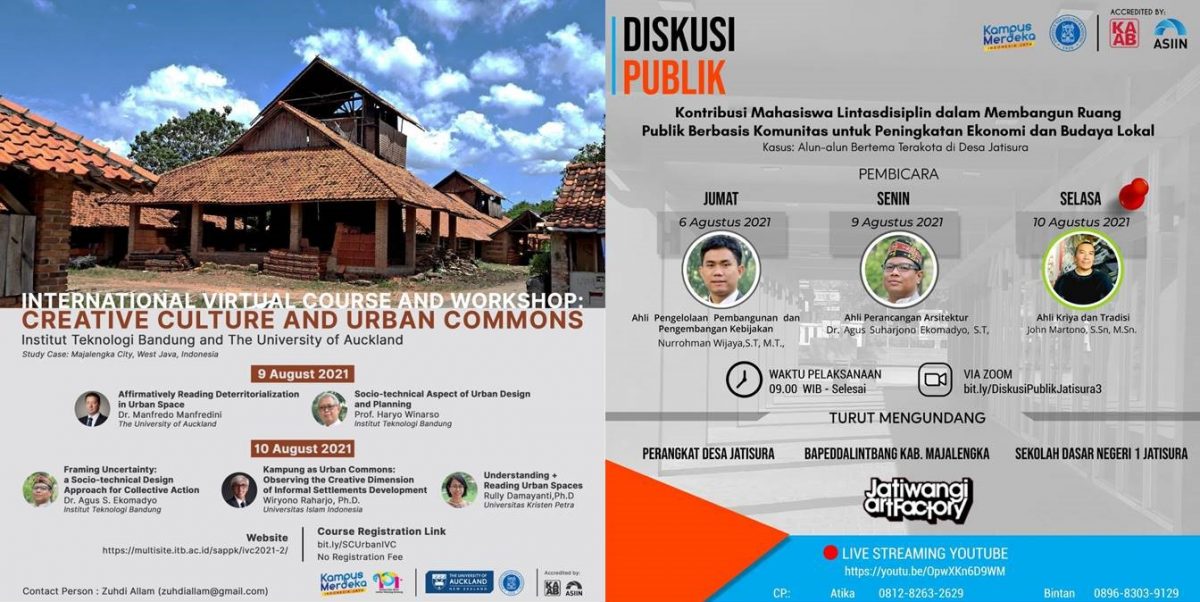Materi Presentasi pada:
- International Virtual Course “Creative Culture and Urban Commons”, International Virtual Course Creative Culture and Urban Commons Institut Teknologi Bandung and the University of Auckland, August, 10, 2021:Ekomadyo (2021) – Framing Uncertainty (IVC CCUC)
- Pembekalan Program Merdeka Belajar Kampus Merdeka (MBKM), Kontribusi Mahasiswa Lintas Disiplin dalam Membangun Ruang Publik Berbasis Komunitas untuk Peningkatan Ekonomi dan Budaya Lokal, Kasus: Alun-alun Bertema Terakota di Desa Jatisura Kecamatan Jatiwangi Kabupaten Majalengka, Sekolah Arsitektur Perencanaan dan Pengembangan Kebijakan, Institut Teknologi Bandung, 9 Agustus 2021:Ekomadyo (2021) – Arsitektur yang Memberdayakan (Pembekalan MBKM Jatisura)
Hubungan Actor-Network Theory (ANT) dan desain memang belum lama. ANT sendiri baru muncul tahun 1986, ketika tiga tokoh utamanya John Law, Michel Callon, dan Bruno Latour, mulai mempublikasikan tulisan masing-masing secara terpisah (Law, 1986, Callon, 1986, Latour, 1986) untuk selanjutnya mulai intensif membangun pemikiran bersama tentang ANT. Dalam dunia desain, pengaruh signifikan ANT terjadi pada tahun 1999, ketika Latour memberikan keynote speech pada sebuah konferensi desain (Latour, 1999a), merespon dunia desain yang mulai melihat bahwa desain merupakan fenomena yang berjejaring, bukan sekadar suatu kerja seorang desainer yang mencoba menyelesaikan suatu permasalahan tertentu. Di situ, Latour secara eksplisit menyebut bahwa pemikiran desain dia secara filosofis dipengaruhi oleh pemikiran Sloterdijk (2009): “Dasein ist design… Sloterdijk has managed to extirpate … from the bifurcated way in which it has always dealt with materiality; this seriousness about Dasein is what makes his philosophy so exciting…; You cannot indulge anymore into the idea that there are, on the one hand, objective material constraints and, on the other, symbolic, human subjective ones.” Secara bersama-sama, Latour dan Sloterdijk diundang berdiskusi oleh arstitek Mohsen Mostafavi pada Harvard University Graduate School of Design pada kuliah publik tentang “Network and Sphere” (Latour, 2009b, Sloterdijk 2009b).
Di sisi lain, design thinking berkembang secara luar basa, karena dianggap cara berpikir yang biasa dilakukan oleh para desainer, termasuk arsitek, bisa diadopsi pada disiplin lain untuk menyelesaikan aneka masalah. Adalah Peter Rowe (1986), yang menerbitkan buku bertajuk “Design Thinking”, di mana ia mencoba mengungkap apa yang sesungguhnya dipikirkan oleh para arsitek sebagai desainer karena banyak masalah yang rumit (wicked problems) yang bisa mereka selesaikan. Design thinking kemudian berkembang ke disiplin lain, terutama pada disiplin Teknologi Informasi untuk melengkapi cara berpikir sistem (system thinking) yang dianggap kurang lentur untuk menyelesaikan permasalahan teknis dan non-teknis, hingga sampai ke disiplin bisnis dan inovasi dalam menemukan cara-cara baru yang bisa diterima oleh pengguna teknologi. Karena banyak sekali pengertian design thinking, pemikir desain Kees Dorst (2011) mencoba merumuskan inti dari pemikiran ini sebagai “IF we look at the problem situation from this viewpoint, and adopt the working principle associated with that position, THEN we will create the value we are striving for”.
Konsep “framing” sebagai inti dari design thinking, juga pernah disebut dalam ANT, meski secara parsial. Adalah Michel Callon (1998) yang mencoba menggunakan ANT untuk mendeskripsikan jejaring pasar, dan mengidentifikasi bagaiman peran alat-alat pasar (market devices) dalam pembentukan jejaring tersebut. “Framing”, menurut Callon, diartikan sebagai “.. is an operation used to define individual agents which are clearly distinct and dissociated from one another; it also allows for the definition of objects, goods and merchandise which are perfectly identifiable and can be separated not only from other goods, but also from the actors involved, for example in their conception, production, circulation or use”.
Sebelumnya, ANT melihat desain sebagai kegiatan preskripsi, di mana desainer memasukkan nilai-nilai tertentu sebelu mambuat skrip. Ekomadyo & Riyadi (2020) membangun argumentasi, bahwa “…design is a kind of ‘pre-scription activities’: every actor acts designing when he/she developing values before they make scripts, when professional designers use specific design devices in these script-making; In ANT, pre-scription activities refer to what actors imagine before the create scripts, as like as designers imagine the design result before they draw the design objects; everybody can create prescription, but professional designers have specific design devices, such drawings, models, or presentations, to insert values on their scripts”. Apakah ANT bisa membuat definisi yang lebih operasional tentang Desain? Pertanyaan ini akan dijawab pada paper selanjutnya.
Referensi:
Callon, M. (1986). “Some Elements of a Sociology of Translation: Domestication of the Scallops and the Fishermen of St Brieuc Bay.” pp. 196–233 in Law, J.. Power, Action and Belief: A New Sociology of Knowledge. Routledge & Kegan Paul, London.
Callon, M. (1998). An Essay on Framing and Overflowing: Economic Externalities Revisited by Sociology. The Sociological Review, 46 (1) 244-269, https://doi.org/10.1111/j.1467-954X.1998.tb03477.x
Dorst, K. (2011). The core of ‘design thinking’ and its application. Design Studies, 32(6), 521-532 https://doi.org/10.1016/j.destud.2011.07.006
Ekomadyo, A.S., and Riyadi, A. (2020). Design in Socio-technical Perspective: An Actor-Network Theory Reflection on Community Project ‘Kampung Kreatif’ in Bandung, Archives of Design Research, 33 (2), 19–37, doi: https://doi.org/10.15187/ adr.2020.05.33.2.19,
Law, J., ed. (1986). Power, Action and Belief: A New Sociology of Knowledge. Routledge & Kegan Paul, London.
Latour, B. & Woolgar, S. (1986) Laboratory life: the construction of scientific facts. Princeton University Press, New Jersey.
Latour, B. (2009a). A Cautious Prometheus? A Few Steps Toward a Philosophy of Design (with Special Attention to Peter Sloterdijk). Keynote lecture for the Networks of Design: meeting of the Design History Society. Falmouth, Cornwall, 3rd September 2008
Latour, B. (2009b). Spheres and Networks: Two Ways to Reinterpret Globalization. Essay. Harvard Design Magazine, no. 30 / (Sustainability) + Pleasure, Vol. I: Culture and Architecture.
Rowe, P. G. (1986). Design Thinking. The MIT Press.
Sloterdijk, P. (2009a). Foreword to the Theory of Spheres, in Ohanian, M. & Royoux, J.C. (eds). Cosmograms, M. Lukas and Sternberg, New York. p. 223-241.
Sloterdijk, P. (2009b). Talking to Myself about the Poetics of Space. Interview. Harvard Design Magazine, no. 30 / (Sustainability) + Pleasure, Vol. I: Culture and Architecture.

